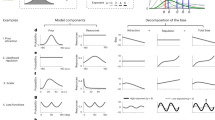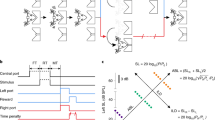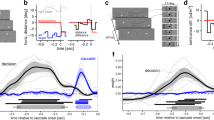Abstract
THE question of the proper empirical basis of the ‘psychophysical law’ has caused much controversy. It has been held that ‘indirect’ methods of scaling ‘sensation’, such as cumulating j.n.d.'s, lead to log functions, and ‘direct’ procedures to power functions, and argument has usually been directed to showing that one type of procedure is better than the other, and therefore that one function, but not the other, gives the ‘correct’ measure of sensory magnitude. However, it can be argued that this aim is misconceived1. In either type of procedure the subject performs a sensori-motor task under instruction, and what we record, on conventional physical scales, are the stimulus intensities (I) administered, and the responses (R) elicited. These are the data, and if we are to have something further to measure we need some model of the intervening processes. Perhaps the simplest model is that which assumes that when a stimulus is presented to the subject it produces a central effect, C, lawfully related to the stimulus intensity, I, and that C functions as a measure of the stimulus, being used to determine the selection of the response, R. C is then related to I by a ‘stimulus function’, C = f(I), and a corresponding response function or lawful procedure relates it to R. Evidence on the relation of I to R, alone, is insufficient simultaneously to specify both functions; only if an arbitrary or conventional choice of one function is made can the data serve to determine the other. Since numbers do not inhere in events or objects, but are assigned by us in accordance with some rule, our initial specification of one of the functions is equivalent to the choice of a rule for scaling C. If we decide that when a response criterion is reached we will consider that a constant increment (j) has been added to C, the stimulus function found will be logarithmic; if we assume that there has been a constant proportional increase (d) in C, a power function will be given; and this is true whether ‘direct’ or ‘indirect’ procedures are used; either law can be derived from either set of data, given the appropriate initial assumptions. Further, it was suggested that C should be taken as a measure we attach to an inferred neural effect of the stimulus.
This is a preview of subscription content, access via your institution
Access options
Subscribe to this journal
Receive 51 print issues and online access
$199.00 per year
only $3.90 per issue
Buy this article
- Purchase on Springer Link
- Instant access to full article PDF
Prices may be subject to local taxes which are calculated during checkout
Similar content being viewed by others
References
Treisman, M., Nature, 198, 914 (1963).
Stevens, S. S., Amer. Sci., 48, 226 (1960).
Treisman, M., Quart. J. Exp. Psychol. (in the press).
Treisman, M., Brit. J. Phil. Sci., 13, 130 (1962).
Author information
Authors and Affiliations
Rights and permissions
About this article
Cite this article
TREISMAN, M. Neural Effects and the Psychophysical Law. Nature 200, 1241–1242 (1963). https://doi.org/10.1038/2001241b0
Issue Date:
DOI: https://doi.org/10.1038/2001241b0
Comments
By submitting a comment you agree to abide by our Terms and Community Guidelines. If you find something abusive or that does not comply with our terms or guidelines please flag it as inappropriate.



